My parents are pretty healthy people and have always leaned toward natural ways to deal with health issues. My dad has dealt with seasonal allergies for years. He tried everything to relieve them and never found a solution! Well, so he thought.
His boss told him how wheatgrass is supposed to help relieve allergies. So my dad gave it a try. It worked! Now it did not work overnight it took a few months for it to start working but within that year my dad’s allergies were basically gone.
But what does that have to do with growing wheatgrass? Well, My dad takes wheatgrass just about every day. And it is not cheap and it can be kind of hard to find sometimes. So why not grow your own? It’s really very simple and you can get started with a bag of wheatberries.
The cool part is that you cut it down and it will grow back. There is controversy on this but what I found is that you can let it grow back about 3 times. After the third cutting you will just start the process over…But I am getting ahead of myself so lets start at the beginging.
How do you grow wheatgrass at home? Well, let me show you…
Okay, before we get started let me explain the differnet ways you can grow wheatgrass.
- Wheatgrass grower ( The fastest and easiest way)
- In soil
- Soiless
- Outdoors
Before we get into the process I just want to explain that the wheat berries are your “seeds” so when I refer to seeds, wheat or wheatberries it is the same thing.
Wheatgrass grower Instructions
1.Buy this On amazon (click the picture for link)
2. Buy your wheatberries (seeds) on amazon. (click the photo for link)
3. Prepare wheatgrass
- Soak seeds for 10 hours
- Layer seeds on the tray
- Put water in bottom tray
4. Care for Wheatgrass
- Change water 3 times a day ( put in about 1/4 inch of water)
- Mist the seeds with water bottle twice a day
5. Harvest Wheatgrass
- Cut down wheatgrass with scissers
Notes:
Leave a little of the wheatgrass so that it can grow back.
Soil Instructions
- Pick a Container
This will be different for everyone. If you have a large family and want to grow wheatgrass for them all, then you will clearly need a large container. But if you just need wheatgrass for your own personal use then I would just use a small container.
You can use a mason jar if you just need a small amount. If you want a large amount I would use a large shallow dish. You can buy planting containers or use any dish you have around the house. A plate will work or a pie dish!
- Pick your wheatberries
Really any wheatberries will work this is just an option for you!
- Get good Soil
Now you can be lazy like me and use your own soil. Which I mean I am lazy but I also have good composted soil so its not all bad. Or you can buy some planting soil.
- Soak your seeds
Soak your seeds in water for 8 hours
- Plant your wheatgrass
1.Put about a 1/4 inch of soil in your container.
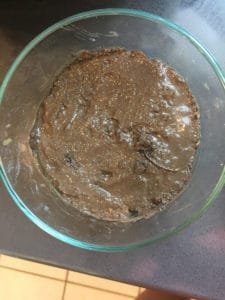
2. Layer your seeds. Lay them nice and close toegther it is like normal grass and grows in close together. You won’t need to worry anout thinning it.
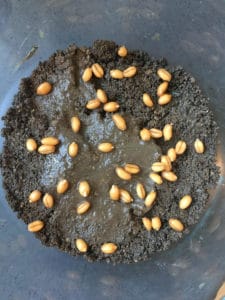
3. Another layer of soil! Put down another layer of soil about the same as you did on the bottom layer.
If you can I would keep your container in a sunny window. But it will also work in partial light as well.
- Waterging your wheatgrass
It is very important to water your wheatgrass but if you are like me you will have a tendacy to forgot to water it and then drown it when you do remember. The best way to avoid that issue is to put water in a spray bottle and lighty mist your wheat grass twice a day.
- Using and harvesting your wheatgrass
When your wheatgrass gets to about 6-8 inches you can begin to start using it. At this point you will take a scissors and cut it down. Now you don’t want to cut it so low that it can’t continue to grow back. You want to leave about an inch at the base of the plant.
Once you get your wheat grass growing you should be able to harvest some each day. I would suggest that you start juicing wheatgrass so that you can start reaping the benefits. If that is something that interests you keep reading and I will explain how to do that!
Soiless Instructions
- Pick a container
You will need a container with holes in the bottom and then another continer to set it in. You are creating a way for the water to drain out.
You could use a fruit contantier that already has holes in it or you can just poke hole in any container that you have.
- Pick your wheatberries
- Soak your seeds
Pour your seeds into a container and put in twice as much water, leave on your counter to soak for 8 hours and up to 24 hours.
- Strain seeds
Put paper towels into a strainer and pour in your seeds.
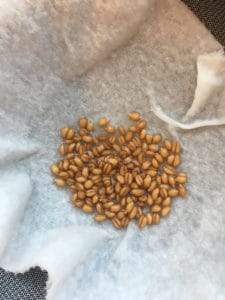
Wrap your seeds in the paper towel and make sure to soak the entire thing. Place wrapped up seeds into the container you picked and place on counter.
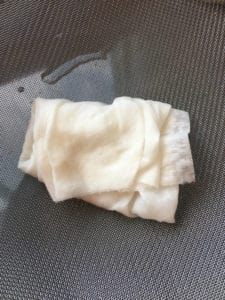
- Keep soaking
Keep your seeds in the paper towel for 2-3 days. Make sure to keep the paper towel wet the whole time. You should only have to soak it a couple times a day.
- Planting your seeds
At this point your seeds should have little tails which mean they are sprouted. At this point they are ready to plant. Take you container with the holes and put a layer of seeds down. You don’t want a think layer but you want them all touching.
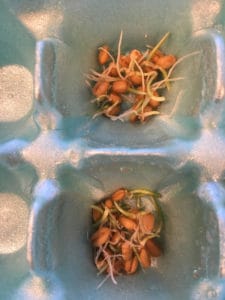
Place another tray under your containter with holes. Place it on the edge of a sink or someplace it can drain into. This is important because you don’t want water sitting in the seeds because it will grow mold.
- Water your seeds
Twice a day pour water over your seeds and completly soak them.
- Harvest your Wheatgrass
By day 12 you should be able to harvest your wheatgrasss. To harvest your wheatgras all you have to do is cut it down with scissors. Don’t cut it all the way down becuase it will grow back and give you a second cutting.
Outdoor Instructions
You can totally grow wheatgrass outside. Actaully, from my research It seems that growing it outside is the best option. Just like anything you would grow outside it will do better beacuase it is getting the nutrients and natural sunlight that it needs.
The only thing about growing it outside is that it is harder to keep an eye on. But if you can keep a close eye on it by all means grow it outside.
You can start from scratch growing wheatgrass outside. But I would suggest taking a patch of your wheatgrass you started inside and planting that outside. This way you know that it will have a little bit of a head start.
More on outdoor wheatgrass…
It was so interesting learning about wheatgrass. Everywhere you look everyone is telling you to grow your wheatgrass indoors. And if that is your only option then by all means go for it. But as I was digging deeper into the subject of wheatgrass I found that growing wheatgrass outside is really the best option.
When you grow it inside you are in a sense forcing it to grow faster with warm tempatures. When really wheatgrass needs time and natural sunlight and good soil.
Ideally you should plant your wheatgrass in the early fall so that the soil is still warm from the summer but the days are cool. Your wheatgrass will not look like it is growing but it is actaully devolping good strong roots underground.
Your wheatgrass will need about 200 days to reach its peak nutrotional value. At this point you can cut it down and reap all the benefits of pure organic wheatgrass.
Other Wheatgrass Questions
How long will it last?
Refridgerator
Wheatgrass will last about a week. But if you are growing it yourself it is best to just harvest it as you need it. It holds onto its nutritional value longer this way and you don’t have to worry about it going bad. But if this is not an option for you plan on storing your wheatgrass for about a week.
Freezer
If you have a suprplus of wheatgrass and can not go through it in a week then I would suggest you freeze it. Frozen wheatgrass will last for up to 3 years! Just make sure you package it well.
The best way to do this is to make your wheatgrass juice and then pour it into ice cube trays. Let them totally freeze. Once they have frozen completly pop them out of the trays and store in the freezer in ziplock baggies.
Now you have wheatgrass whenever you need it!
How to store it?
Speaking of storing. The best way to store wheatgrass is by keeping it in an airtight container in the fridge. You can use glass containers, plastic containers or zip-lock baggies.
Juicing Wheatgrass
So now that you have an abundance of wheatgrass what is the best way to use it? As I mentioned above my Dad was the one who started on the wheatgrass trend in our family. Before that, I did not know anything about it. My dad’s favorite way to get it in is by juicing. You can juice it by itself but it is very strong. So I would suggest juicing it with an apple. So how about an amount?
How much wheatgrass should you take a day?
I feel like when you do natural things like this it is always hard to know how much to take. And honestly, it will be different for everyone. It is suggested that you take anywhere from 1-4 ounces a day.
Start small and see how you feel. You can always slowly build up to 4 ounces. It is also a good idea to drink a big glass of water after you take the wheatgrass. Drinking water will reduce your chances of dealing with side effects.
Wait…There are side effects?
You will most likely be totally fine. When you are doing natural things you will sometimes have small side effects but nothing crazy. The only side effect you might experience from wheatgrass would be nausea and possibly constipation from the high fiber count.
But like I said if you start small you most likely will not have a problem at all. And the benefits totally outweigh the possible side effects.
Wheatgrass Benefits
Let me preface this by saying that wheatgrass will not “cure” you of any of the following ailments. It is a great supplement found in nature and I have seen it really help people but don’t think that it is a “cure-all”. Everybody is so different and things work completely different on every bodies body.
1. Allergy Relief
I started with this one because this is how I was introduced to wheatgrass in the first place. Like I said my dad started using wheatgrass for allergies after he had tried everything else out there. Within a year his seasonal allergies were basically gone. I was so impressed but I did not know why it worked I just know it did. But I figured I would have to learn the “why” behind it so I could explain it better.
From my research allergies come from a weakened immune system. So if you can strengthen your immune sytem you are less likely to deal with seasonal allergies. As we talked about everbody is different so you will have to test and see what works for you. My dad juices about a handful of wheatgrass with an apple every day and has found success in that.
2. Cancer prevention
Wheatgrass is very high in antioxidants and can potentially kill cancer cells. Again, this is not a guarantee, but for me who lost my grandma to cancer, I will do anything I can to help prevent the same thing in my body.
3. Healthy skin
As I mentioned Wheatgrass has loads of antioxidants which has anti-aging properties. What I like about this is you are healing your body from the inside out. Most creams and topical things are working on the outside but is really not fixing the inside. With things like wheatgrass, you are working on the actaul issue and not just slapping a band aid on the syptom.
4. Avoid hair damage
This stuff is crazy! Wheat grass is known to be a super food and to be cleansing. It will remove dead skin cells from your head. This may sound strange but you can take the wheat grass juice and rub it onto your scalp. Leave it there for 15-20 minutes and then rinse out with shampoo.
I know it sounds strange but don’t knock it til you try it!
5. Regulating Blood Sugar
When your blood sugar is whacked out you will deal with all sorts of issues. In the US this has been a huge issue with our poor diets. Because of high blood sugar, we deal with, things such as fatigue, obesity, dehydration, headaches Etc. Regulating our blood sugar can be very hard to control.
But studies are coming out showing that wheatgrass can aid in regulating blood sugar.
6. Weight loss
We all could lose a few extra pounds and wheatgrass can give us the little boost we need. Most of us have not eaten the greatest and have toxins in our bodies. This can hinder your weight loss journey. Wheatgrass will start removing those toxins from your body so that you can start losing those extra pounds.
7. Increase energy
As a young mom I am all about getting in some extra energy. But I refuse to drink those energy drinks full of garbage. Coffee does not work for me because it makes my mind run like crazy as soon as I get into bed at night. The only thing I have found to help is hemp CBD oil. But holy smokes that stuff is pricy.
So you can bet I am gonna go for the stuff I can grow at home for alomost nothing!
Wheatgrass is high in protien and enzymes. Which in turn gives your body a boost of energy. I don’t know exactly how that works I just know it does.
Other Uses For Wheatgrass
Other then the items I mentioned above there are other ways wheatgrass can be used.
- Cats
I am not a cat person and personally do not have a cat. But from what I was learning you can feed wheatgrass to your cat and it will have the same benefits for your furry friend as it does for us humans.
2. Decoration
This is so fun! I love doing things that are practical and cute. You can use your wheatgrass for decoration. So basically you will just take the steps I provided above but just plant some wheatgrass in a cute little container or jar. You can decorate with it and just cut it down as you want to use it. How cool is that?
Conclusion
Wheatgrass is pretty crazy stuff! It can help your body kill cancer cells, give you glowing radient skin, relieve allergies and more! I love when I find things that are almost free to come by and have such a large positve impact on my body. And how cool is it that I can grow it in my house and use it as a cute docoration and cut it down as I need to juice it? Pretty awesome if you ask me.
I love finding “non traditional” ways to heal my body, clean my home, and teach my kids. And my favorite is when I find things that work REALLY work well. Here is another one of my posts that you might be interested in.




